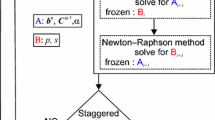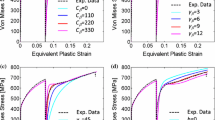Abstract
The role of constraint in ductile fracture has been studied for its effect on fracture toughness. When toughness is characterized by the J−R curve, a lowering of constraint will usually increase the level of the J−R curve. In a ductile fracture methodology both the J−R curve and the calibration functions which relate the applied load to the plastic deflection of a structure, are required to predict structural behavior. Constraint also influences the calibration functions. In many cases the calibration functions play a more important role in the prediction of maximum load than does the J−R curve. Therefore in predicting the behavior of a structural component the effect of the constraint must be accounted for in determining the calibration functions to be used as input in the ductile fracture methodology.
The calibration functions have been traditionally taken from the EPRI-GE Handbook [6]. Using the format of the Handbook calibration functions, a constraint factor Ω is derived which can be used to evaluate the relative constraint in the calibration function. For prediction of the behavior of a structural component from a laboratory test specimen the constraint factor must be known for each component. This constraint factor for the test specimen can then be used to predict the calibration function that is appropriate for the geometry and constraint of the structural component.
A number of examples taken from test specimens of various thicknesses are presented to show that the constraint factor for the calibration function can be reasonably predicted based on information given in the Handbook. This method of prediction is applied to develop calibration functions that can be used in a ductile fracture methodology for a new structural constraint. The methodology is then used to predict load versus displacement behavior for cases of different constraints. Results from a test with essentially plane strain constraint are used to predict behavior of a plane stress structure. Finally a list of general rules is developed to account for the constraint of an arbitrary structural component. Along with this, some indication is given of where additional information is needed to make the prediction of constraint more complete.
Similar content being viewed by others
References
J.D. Landes, Z. Zhou and K. Brown, in Fracture Mechanics: Twenty-Third Symposium, ASTM STP 1189, Ravinder Chona (ed.) (1993).
R.E. Link, J.D. Landes and R. Herrera, Defect Assessment in Components-Fundamentals and Applications, JG. Blauel and K-H Schwalbe (eds.) ESIS/EGF Publication 9, Mechanical Engineering Publications Limited (1991) 985–1003.
R.E. Link, J.D. Landes, R. Herrera and Z. Zhou, Defect Assessment in Components-Fundamentals and Applications, J.G. Blauel and K-H Schwalbe (eds.) ESIS/EGF Publication 9, Mechanical Engineering Publications Limited (1991) 707–721.
G.P.Gibson and S.G.Druce, Advances in Fracture Research, Proceedings of ICF-7, vol. 1 (1989) 181–188.
J.D. Landes and Z. Zhou, ‘A Ductile Fracture Mechanics Methodology for Predicting Pressure Vessels and Piping Failure’, presented at the 1991 ASME Pressure Vessel and Piping Conference, San Diego, CA, June 1991 (PVP-vol. 213).
V. Kumar, M.D. German and C.F. Shih, An Engineering Approach for Elastic-Plastic Fracture Analysis, NP 1931, EPRI Project 1237–1, July 1981.
J.G. Merkle and H.T. Corten, ‘A J-Integral Analysis for the Compact Specimen, Considering Axial Force as Well as Bending Effects’, ASME Paper No. 74-PVP-33 (1974).
H.A. Ernst, P.C. Paris and J.D. Landes in Fracture Mechanics, Thirteenth Conference, ASTM STP 743, Richard Roberts (ed.) (1981) 476–502.
M.H.Sharobeam and J.D.Landes, International Journal of Fracture, 47 (1991) 81–104.
J.D.Landes, Z.Zhou, K.Lee and R.Herrera, Journal of Testing and Evaluation, JTEVA, 19, No. 4 (1991) 305–311.
J.D. Landes and J.R. Donoso, ‘Common Format for Developing Calibration Curves in Elastic-Plastic Fracture Mechanics' submitted for publication.
J. Donoso, C. Mora and F. Labbé in Proceedings of the Latin American Regional Welding Congress, Brazil vol. 3 (April 1992) 1293.
Author information
Authors and Affiliations
Rights and permissions
About this article
Cite this article
Donoso, J.R., Landes, J.D. The role of constraint on the calibration functions for the prediction of ductile fracture behavior in structural components. Int J Fract 63, 275–285 (1993). https://doi.org/10.1007/BF00012473
Received:
Accepted:
Issue Date:
DOI: https://doi.org/10.1007/BF00012473




